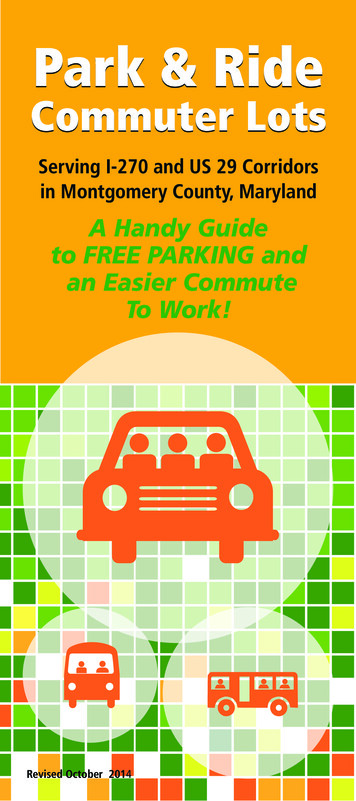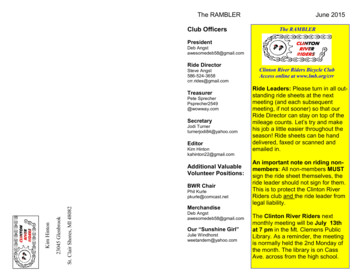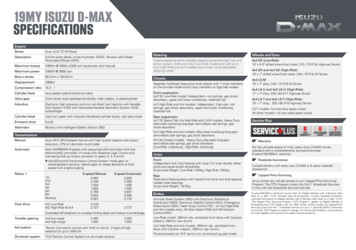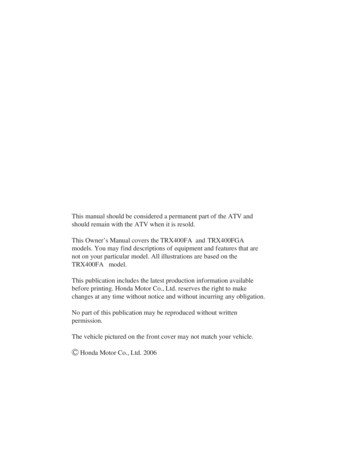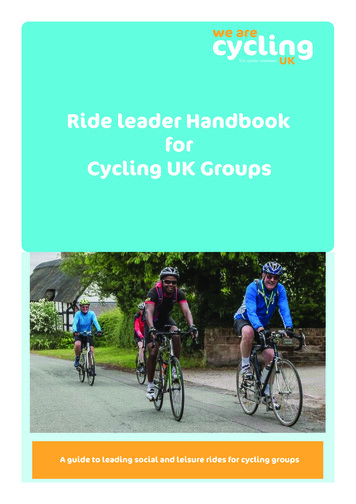
Transcription
Ride leader HandbookforCycling UK GroupsA guide to leading social and leisure rides for cycling groups
ContentsIntroductionp3The Ride Leader RoleWhat does it take to be a ride leader?What are the benefits of being a ride leaderHow to become a ride leaderHow to have peace of mind when leading a ridePlannning a Group RideWhy do people go on a group ride?How to plan a great rideWhen to carry out a risk assessmentRide EtiquetteEmergency operating proceduresFurther p12p13p14p16p17p18p19p20p21p22Cycling UK Ride leader Handbook v.2p5p6p7p8p9p1017/12/2021Vols/JR
IntroductionBeing a ride leader is enjoyable, rewarding and fun: you have the satisfaction of sharing yourknowledge and skills with others and you get to choose when and where you ride. You are alsohelping Cycling UK fulfil its mission of enabling millions more people to cycle.These guidelines will help you and your group get the most out of the experience. It looks atthe resources you might need to plan and lead an enjoyable leisure or social ride, whether onor off-road and also guides you through the insurance, legal and other requirements. It is notprimarily aimed at groups more interested in racing or peloton-style rides.Our heritageCycling groups are the backbone of Cycling UK’s activities: our volunteers have been involvedin running them since we were founded back in 1878. Whether groups are run by and forour members (Member groups) or are affiliated to us, we believe they should be run to makecycling with a group safe and enjoyable for everyone: both riders and the volunteers who puton activities for them.Our missionWe are Cycling UK, the national cycling charity. Our mission is to enable millions morepeople to cycle. Whether it’s for the thrill of the wind in your hair, or being out in the openin the fresh air, we all love to ride our bikes. It’s fun, it’s healthy and it’s good for theenvironment.Founded in Harrogate on 5 August 1878 by Stanley Cotterell, we promote all forms ofcycling, inspiring people of all ages, backgrounds and abilities to discover the joys of cycling.As well as supporting our members, we also play a prominent campaigning role, fighting todefend cyclists’ rights for safer roads, better infrastructure and legal protection.Best practiceThis guide to ride leading is based on the best practice that Cycling UK, its clubs, groups andinstructors have accumulated over the years. The policies in this handbook have been setby Cycling UK and are designed to enable groups to carry out cycling activities legally andefficiently, with the minimum of bureaucratic intervention.Cycling UK’s policies and related statements provide a structure in which Affiliated Group andmember group activities can take place safely. Our policies must be followed by Cycling UKmembers, staff and volunteers involved in delivering or supporting Cycling UK activities.Cycling UK Ride leader Handbook v.2p317/12/21Vols/JR
The Ride leader Role
What does it take to be aride leader?Being a ride leader is a rewarding activity, enabling more people to experience the joy ofcycling, whether in a town or city, or out in glorious countryside. Volunteer ride leaders maycome from all sections of the community, whether experienced group members or relativelynew to the activity.There are no particular qualities, training or knowledge required to lead a leisure ride,except perhaps common sense and an enthusiasm for cycling, alongside a desire to sharethat passion with others. However, professional qualifications are available (see FurtherResources p23). Other attributes might come in useful that make the experience moreenjoyable for all, including: PatienceA friendly, welcoming attitudeA sense of humourEmpathyPunctualityFlexibilityIn addition to the above, a few practical skills may come in handy. For example: Navigational skills - either using a Garmin-style device, paper maps or just good localknowledge Bike maintenance skills - sometimes you may be asked to help with small adjustmentsto riders’ bikes but extensive mechanical knowledge is not expected First Aid skill - formal qualifications are not usually required (unless you are aprofessional ride leader/instructor or you are leading rides for a particular institution ororganisation.) Note that Cycling UK recommends that only qualified first aiders carry outfirst aid. Knowledge of the Highway and Countryside Codes - it’s important not to give cyclists abad name by, for example, riding on the footway or on footpaths. Communication skills to help convey instructions and understand the needs of yourriders An understanding of our ride leader checklist and our other guidanceRemember that different people can bring different things to rides, so don’t worry if youcan’t meet all these expectations - perhaps you have other knowledge, skills or experiencethat are useful? For example, you might know all about local wildlife or a city’s hiddenlandmarks to make a ride more interesting.Cycling UK Ride leader Handbook v.2p517/12/2021Vols/JR
What are the benefits of being aRide leader?Volunteering as a ride leader not only benefits the wider community by enabling people tobe happier and healthier through cycling, it also benefits those who perform this essentialtask.Sharing local knowledge and love of a particular area is very rewarding. As ride leader, youusually get to choose the time, day and distance of the ride, as well as the stopping pointsalong the way. So, whether you enjoy a gentle pootle and a leisurely catch-up over coffee,or you’re more of a head down mile-eater, the pace and style of the ride is entirely up to you(taking into account any specific needs of your riders too, of course)!As ride leader, you may also enjoy better fitness, due to having to commit to actuallyturning up for the scheduled ride - (try never to cancel a ride unless there are extenuatingcircumstances such as illness or extreme weather conditions). Some people struggle withmotivation but being the ride leader means you have a cast iron incentive to get out of bedand go outdoors, even if you’re not particularly feeling like it - and you’ll feel the better for it.Riding in a group is a social activity and you will automatically be extremely popular fortaking on the role of ride leader, having the opportunity to make new friends, and possiblybenefit from their experience and knowledge of cycling too.However, occasionally you may find you are out front leading while everyone is busy chattingin the bunch behind you! This may be a little frustrating if you like a chat too but at least youhave the satisfaction of knowing that your riders are enjoying the ride.As ride leader, you have duty of care to the people you are leading to ensure that they havea good time and stay as safe as possible while out on their bikes so a little preparationbeforehand will make this task easier.Cycling UK Ride leader Handbook v.2p617/12/2021Vols/JR
How to become a ride leaderThere are usually no formal qualifications required for the role in a local group or club setting.However, Cycling UK offers courses in group leading that lead to a recognised qualification ifrequired - see Further Resources p24.For Cycling UK member groups, we just require the names of a proposer and seconder fromwithin the group who can vouch for your competence to lead rides (note that Member groupvolunteers must all be full members of Cycling UK and registered with us) by emailing groups@cyclinguk.org.For Affiliate groups, we strongly recommend that any volunteers are registered with us forinsurance purposes and that they are also listed as members of your group or club, howeveryou choose to do this.Once you have been registered as a ride leader by your group, you are then covered to leadrides under our Organisers’ Liability insurance. You can also lead rides before then if necessarybut please make sure you are registered with us as soon as possible afterwards.Before leading your first rides, however, it would be a good idea to familiarise yourself with therecommendations in Appendix 1: Ride leader checklist plus any local instructions or guidanceyour group or club provides.Cycling UK Ride leader Handbook v.2p717/12/2021Vols/JR
How to have peace of mind whenleading a rideIntroductionMany people are concerned about issues around liability when leading a ride. Ride leadingis a voluntary role but, nevertheless, ride leaders do have a duty of care to ensure that theexperience is as safe and enjoyable for participants as is reasonably possible. Claims againstride leaders are extremely rare. With the protection of Cycling UK’s insurance, and our longhistory of organising cycling activities, you can relax and enjoy the experience. Below is asummary of the cover in place so bear these points in mind when thinking about the kind ofride or event you’re planning, and read them alongside the current Insurance Guidance Notesat: ote: Cycling UK member groups and affiliate groups must abide by our guidance forinsurance purposes, but other bodies may have their own rules and regulations to be followedin addition for example, community cycle clubs, schools and youth groups.Our coverRide leaders are covered by our master insurance policy, as long as they are registered withCycling UK and lead rides for either a Cycling UK member group or a cycling group affiliated toCycling UK. The main points of our Organisers’ Liability guidance are:Affiilate groups You are covered as a ride leader for damage caused to a third party during a ride whichleads to a claim against you or your group as organisers. You must be a fully paid-up member of your group and registered to lead rides. You are NOT covered for organising any form of competitive event, except as listed in theGuidance Notes. You are covered for social events run as part of the ride eg tea stops, barbecues. You should have no more than ten non-members of your group on any one ride. Non-members of your group should not ride any more than three times with the groupbefore being asked to join. These limitations do not apply to ‘events’ open to both members and the public, whichshould be registered with Cycling UK. Cycling UK must be informed of events/rides involving more than 200 riders by registeringthe event on our Events Guide. You are covered for rides/events in collaboration with other bodies, provided your group isclearly the organiser and the ride/event is run in accordance with our guidance. You are covered for any ride/event which takes place anywhere except USA/Canada.Note: Riders may only be covered third party if they are also members of Cycling UK or anotherorganisation that provides this.Cycling UK Ride leader Handbook v.2p817/12/2021Vols/JR
Member Group CoverMember groups You are covered as a ride leader for damage caused to a third party during a ride whichleads to a claim against you or your group as organisers. You must be a full member of Cycling UK and registered with us to lead rides. You are NOT covered for organising any form of competitive event, except as listed in theGuidance Notes. You are covered for social events run as part of the ride eg tea stops, barbecues. You should have no more than ten non-members of Cycling UK on any one ride. Riders who are NOT Cycling UK members are covered for claims made against them byanother Cycling UK member on a member group ride ONLY. Non-members of Cycling UK should not ride any more than three times with a Cycling UKmember group. These limitations do not apply to ‘events’ open to both members and the public, whichshould be registered with Cycling UK. Cycling UK must be informed of events/rides involving more than 200 riders by registeringthe event on our Events Guide. You are covered for rides/events in collaboration with other bodies, provided your group isclearly the organiser and the ride/event is run in accordance with our guidance. You are covered for any ride/event which takes place anywhere except USA/Canada. Affiliate members may ride with Cycling UK member groups but may not lead rides for them.Note: We strongly advise ride leaders and event organisers to familiarise themselveswith the current Guidance Notes, which are updated every October, and can be foundat: cyclinguk.org/insurance/event-organiserCycling UK Ride leader Handbook v.2p931/ 01/2020Vols/JR
Safeguarding Code of ConductIt is the policy of Cycling UK to make every effort to safeguard its members from physical, sexualand emotional harm while participating in Cycling UK activities. Cycling UK takes all reasonablesteps to ensure that, through relevant procedures and training, children, young people and adultstaking part in Cycling UK activities do so in a safe environment. All our policies around safeguardingcan be found in the Cycling UK website at: cyclinguk.org/article/legal-guide/safeguardingAll Ride leaders, instructors and other volunteers have an obligation to avoid creatingdistressing situations. Therefore they are expected to follow the Code of Conduct below:You are expected to: respect everyone as an individual; provide a good example of acceptable behaviour; respect everyone’s right to privacy; show understanding when dealing with sensitive issues; adhere to the organisation’s policies;As a Cycling UK volunteer you may not: permit abusive behaviour; have inappropriate physical or verbal contact with others; jump to conclusions or make assumptions about others without checking facts; make suggestive or inappropriate remarks or actions; deliberately place yourself or others in a compromising situation;Other adults presentRide leaders, instructors and other volunteers should avoid situations where they are alone witha young person or vulnerable adult. This precaution protects all parties by removing the feelingof threat from an insecure participant and by providing a witness if an accusation of improperbehaviour is made. However, there may be occasions where this is not possible and a judgmentwill have to be made as to what is in the best interests of the young person or vulnerable adult.Physical contactPhysical contact between an individual and the Ride leader or instructor or other volunteershould be avoided. There are instances when it is necessary, eg to demonstrate a skill, but suchcontact should remain impersonal so there is no risk of it being misinterpreted.Appropriate languageCare should be taken about what is said, and the way it is said. Leaders, instructors andvolunteers should avoid saying anything which could be interpreted as being aggressive,suggestive, or containing an innuendo.Creating false impressionsIt is important that Ride leaders, instructors and other volunteers do not create a falseimpression. Words and actions can be misunderstood, and care should be taken to avoidawkward situations. Should such a situation arise, it is essential to handle it with care andconsideration to minimise embarrassment to Ride leaders, instructors, other volunteers andparticipants.Cycling UK Ride leader Handbook v.2p1017/12/2021Vols/JR
Planning a Group Ride
Why do people go on a group ride?There are many reasons why people choose to go on a group ride: for example, they maybe nervous about riding on their own due to a lack of mechanical or geographic knowledge;they may like the companionship that riding in a group brings and enjoy the socialinteraction above all else, or they may simply prefer to leave the responsibility of deciding ona route and pace to other people. For many, riding with a cycling group or club is a chance toforget about everyday cares and responsibilities and let other people make the decisions.Other people may have completely different motivations for going on group rides: they wantto feel a sense of progression in their cycling by comparing themselves to others. Otherriders not only provide competition, they can also give encouragement and advice, as wellas being a reliable source of knowledge about local road and trail conditions, other cyclingevents and rides, equipment, holidays and tours and so much more.Predominantly, however, people who go on group rides enjoy the social aspects of riding withother people so remember to allow for this when planning and leading the ride. Appendix2 the Group Rider checklist contains some useful tips to pass on to people new to groupriding.Cycling UK Ride leader Handbook v.2p1217/12/2021Vols/JR
How to plan a great rideRoute planning methodsThe first thing to consider when organising a ride is obviously planning the route. Somepeople will use technical devices such as Garmins and programmes like Strava and Komoot;others prefer tried and trusted methods such as OS paper maps, local knowledge or routesthey’ve previously ridden.What to take into considerationWhatever method you choose, take into account these factors: Is the proposed speed of the ride suitable for you and your riders - do they prefer a fast,slow or medium pace? The terrain - how hilly is it? What are the surfaces like? How busy is the traffic? The likely weather conditions - how will they affect the intended route or riding style?(see section on risk assessment below) The time of year - do you need to be back before dark or can you stay out longer? Willthere be wet leaves and other potential hazards that might affect the plans? Stopping points - is there somewhere en route for riders to use the toilet, grab a hotdrink or snack, have a rest and a chat and so on? Are there any particularly interesting sights, sounds and smells it would be good toinclude to make the ride more interesting? Are they any other events or large rides taking place at the same time?How to increase participationThere may be other factors to consider too but if you tailor the ride to the participant level,ability and intention, that is a great start. Groups that offer a diverse range of activities atdifferent times and dates often succeed in attracting new riders.Cycling UK Ride leader Handbook v.2p1317/12/2021Vols/JR
When to carry out arisk assessmentCompleting a risk assessmentSome organisations may require certain activities to be more formally risk asessed thanothers. At Cycling UK, we believe that it may not be practicable to risk assess every ride inadvance. Therefore, we recommend that if you have an event open to the public ie aimed atriders who are not regular members of your group, you should carry out a risk assessmentand keep it on file for your records.The risk assessment will involve riding the planned route as near to the event as possibleand noting down any likely hazards your riders may encounter. For example, is there aparticularly busy stretch or junction to negotiate? Are there trail features that might bedifficult to tackle by the riders? It might also include the start/finish areas of the ride.Once the hazard is noted, you should then write down any proposed actions that can betaken to mitigate any dangers they pose.Be prepared to review your risk assessment if needs be to take into account, for example,planned or unplanned roadworks and so on. Remember, you may need to vary your route atshort notice so it’s a good idea to have a plan B up your sleeve.Our risk assessment form can be used as a template to record any potential hazards andhow you made allowances for them.Cycling UK Ride leader Handbook v.2p1417/12/2021Vols/JR
Ride Etiquette
Pre-ride ChecksThe day of the ride finally dawns. You meet at the allotted time and place (preferably earlierthan your participants!) and, hopefully, at least one other soul turns up.Pre-ride checksOnce everyone arrives, there are a few brief formalities to go through before you set off,such as finding out who is on your ride and their readiness for the activity, taking a noteof their emergency contact details using the Signing In/Out sheet. Riders under 18 musthave a signed Parental Consent form whether accompanied or not (under 13s MUST beaccompanied by a parent or guardian).Briefing the ridersA short briefing explaining the destination, route and any planned stops is advisable beforethe ride starts. It is also a good idea to introduce new riders and also explain any handsignals or calls used by the group.Don’t forget to point out any known hazards in advance, and reassess the condition of theriders, the route and the weather conditions at regular intervals - be prepared to vary oreven abandon the ride if any of them deteriorate.Although riders are responsible for deciding on their own suitability for the advertisedactivity, ride leaders should greet each participant and assess their general health andwellbeing before starting the ride.Cycling UK Ride leader Handbook v.2p1617/12/2021Vols/JR
Leading the GroupRider equipmentSome organisations and groups require ride leaders to provide a list of suitable items forriders to bring. All riders should bring a suitable cycle for the activity but you may be askedby your organisation to check riders’ bikes. The M-Check sheet and ABC list show how youmight briefly assess somebody’s bike to see whether or not it is safe to ride.Points to note: Cycling UK advocates freedom of choice as regards the wearing of helmets and hi-vizclothing so it is not up to ride leaders to promote or otherwise the pros and cons ofthese. Bear in mind, however, that other organisations may require riders to use certain itemsof clothing and equipment: It is the ride leader’s prerogative to refuse anybody on theirride who they deem to be so ill-equipped they may pose a danger to themselves orothers but note point above on helmets and hi-viz clothing. Cycling UK advocates only making minor adjustments or repairs to a rider’s bike if youare sure you are competent to do so by experience or qualification - our Organisers’Liability insurance may not cover you for this: check the relevant Guidance Notes at:cyclinguk.org/insurance/event-organiser.Leading the groupWhat is the optimal group size for road riding? Should you appoint a backmarker? Whattechniques could you employ to ensure the group stays together? This section discussesways to manage a group ride.Group sizeThere are no hard and fast rules about the amount of people acceptable on a group ride asit depends on many variables, such as: the competence of the riders and ride leaders; thenumber of assistant ride leaders available; the demands of the planned route and so on.As ride leader, you should be confident you can handle the number of people who turnup for the ride. Cycling UK recommends considering dividing up groups of 12-15 or moreinto smaller groups of no more than six and/or appointing an assistant ride leader (orbackmarker) to help keep an eye on the riders.Don’t forget to take a headcount at the start and at regular intervals during the ride,especially if it is a larger group! If people leave the ride part-way through, they should let theride leader know.Cycling UK Ride leader Handbook v.2p1717/12/2021Vols/JR
PositioningPosition of ride leaders and assistant ride leadersWhere should you position yourself during the ride? Is riding always at the front or backnecessarily the best place to be? Consider where else you might be able to ride formaximum enjoyment and security. Think about the best options for the following situations: SituationPosition of ride leaderNormal ridingExample: At front of the groupDescendingClimbingCrossing main trails/roadsStopping pointsJunctionsPosition of assistantBehind last riderPositioning of ridersIt is important that each participant understands that they are responsible for their ownsafety. Encourage them to keep away from the gutter and to watch out for any potentialhazards, which they should point out to other members of the group – see chapter Howto Communicate With The Group. They must also be careful not to ride too closely to eachother or the ride leader.Riding two abreastThe Highway Code in Rule 66 says: “You should never ride more than two abreast, and ridein single file on narrow or busy roads and when riding round bends.” Cycling UK guidelinestherefore are that riders should never ride more than two abreast, except when passingand should drop into single file on narrow or busy roads, unless it would be unsafe to do so.When riding two abreast, the less experienced cyclist should usually ride on the inside.Note: Ride leaders should be aware of the other rules for cyclists in the Highway Code anddo their best to ensure that groups comply with them.Cycling UK Ride leader Handbook v.2p1831./01/2020Vols/JR
Singling Out and CommunicatingWhen should groups single out?It is very much up to ride leaders to decide how and when to move the group from twoabreast to single file or vice versa.If cycling on busier roads, riding two abreast means the group might be more visible andtake up less space so following vehicles can overtake more easily. If possible, it might beappropriate for the group to single out (riding in single file) or even pull in, for exampleon a longer stretch of narrow lane, and allow following drivers to pass safely. Cycling UKguidelines are that riders should show courtesy to other road and trail users and be a goodambassador for cycling.However, you should put the safety of your riders first and avoid singling out if it might leadto dangerous close passing, with drivers being tempted to overtake you where there isnot enough room to do so. Riders are responsible for their own and others’ safety so theymust decide if singling out is appropriate at the time and how the manouvre should beaccomplished, remembering to leave enough room between themselves and other cyclists.How to communicate with the groupMany groups have their own jargon and gestures to communicate warnings and instructionsto each other. For example, some ride leaders shout ‘car up!’ if a car is approaching fromin front, while others might use ‘oil down!’ for a vehicle coming up from behind. Or theopposite. Some groups use a circular hand gesture to signify potholes in the road surface,while others use one hand behind their backs. What terms could you use to communicatewith your group? Don’t assume everybody will know what they mean. Be wary of using termssuch as ‘Clear!’ when at crossings and junctions - let each rider decide for themselves incase it isn’t clear when they decide to cross.Cycling UK Ride leader Handbook v.2p1917/12/2021Vols/JR
Stopping PointsStopping pointsThere might be times when you might need to stop or slow the group down, for examplewhen turning right off a busy main road or before a particular trail feature, or simply toallow others to catch up. If you want to slow or stop the riders, clearly shout ‘Slowing!’ or‘Stopping!’, otherwise there may be a pile-up behind you.Remember, stopping points must be identified for their appropriateness: do they allow thewhole group to get off the carriageway or track, without inconveniencing other users? Peoplecan become sheep-like when in groups so may be prone to stopping wherever they feel likeit, blocking the trail or road. It is your job as Ride leader to prevent this!In mixed ability groups, some riders want continuity of riding and as few stops as possible,while others will welcome frequent rests. Be mindful of this but remember that you can’tplease all the people all the time so aim for the middle ground - however, try NOT to setoff as soon as the slowest riders have caught up with the group. This can be dispiriting,especially if they need a breather and a drink. In any case, allow time for at least a couple ofstops as most leisure riders appreciate a comfort stop and a chance to chat.Cycling UK Ride leader Handbook v.2p2017/12/2021Vols/JR
What to Do If Things Go WrongHow to deal with unexpected incidentsRide leaders should aim to keep the ride flowing as smoothly as possible, allowing time forbreaks where necessary, but there may be times when incidents occur. Some situationsmay arise out of the blue but some can be prevented with a little forethought - for example,carry some small snacks if riders ‘get the bonk’ (run out of energy); appoint a competentrider to backmark and wait at junctions for the tailenders, and so on. However, occasionally,a major incident involving serious injury or even (very rarely) a fatality might occur.In these circumstances, an Accident/Incident Report form should be completed andsubmitted to Cycling UK. This is why it’s important to have a note of people’s emergencycontact details, as well as knowing who to tell if something happens. The EmergencyOperating Procedures on the next page set out what else you need to do should there be aserious incident of any kind.NOTE: Full Cycling UK members are entitled to free legal advice and claims assistance fromour lawyers Slater Gordon on 0844 736 8452 – affiliate members and other riders maystill phone for general advice in the event of an incident involving a third party.Cycling UK Ride leader Handbook v.2p2117/12/2021Vols/JR
Emergency Operating ProceduresWhat to do if there’s a major incident - a step by step guide1. Think of yourself first and make sure you are safe. Count to 10 before acting.2. Get other people off the road or trail and away from danger.3. Make the area safe. Ask for two (or more) people to stop any traffic or other riders ifnecessary.4. Assess the casualty if qualified to do so or ask if anybody has a first aid qualification.Only move the casualty if absolutely necessary.5. Call the emergency services if required by dialling 999 or 112. They will need to knowyour location and the details of the injured parties. Identify your location by either a gridreference or using apps such as what3words.com or OS Locate.6. Send people to guide the emergency services if required.7. Reassure the casualty and, if they are conscious, ask who they would like to becontacted.8. If they are unconscious, try and locate their em
Cycling UK Ride leader Handbook v.2 p3 17/12/21 Vols/JR Being a ride leader is enjoyable, rewarding and fun: you have the satisfaction of sharing your knowledge and skills with others and you get to choose when and where you ride. You are also

